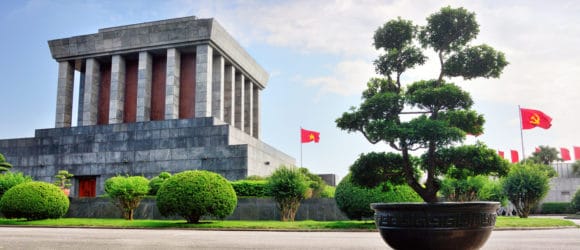Ho Chi Minh Mausoleum in Hanoi, Vietnam

One can’t read about the Ho Chi Minh Mausoleum without learning about the famous corpse on display in the glass sarcophagus for ten months a year. However, the structure itself, which was inspired by Lenin’s Mausoleum in Moscow, is definitely worth the visit – as long as you do the necessary research before making the long trek.
Let’s learn about this famous mausoleum, which honors Ho Chi Minh, the founder of the Viet Minh and the Vietnamese Communist Party.
What You Need to Know About President Ho Chi Minh
Ho Chi Minh (Nguyễn Sinh Cung) was born in 1890 in Central Vietnam. Unfortunately, the details of his early life are often subject to academic debate.
We know that Ho Chi Minh led the country’s communist-led independence movement starting in 1941. In fact, the mausoleum’s site is located where he declared independence from the Japanese in 1945. However, this was followed by a war with the French. The end of the First Indochina War in 1954 resulted in the region’s division, with the Communists controlling North Vietnam. Ho Chi Minh served as the Prime Minister of North Vietnam from 1945 to 1955 and was president from 1945 to 1969.
Ho Chi Minh was a key figure in the People’s Army of Vietnam and the Việt Cộng during the Vietnam War, which lasted from 1955 to 1975. North Vietnam was victorious against the South and its allies, and the region was officially unified in 1976. However, he died before the end of the war. Saigon, the former capital of South Vietnam, was renamed Ho Chi Minh City in his honor.
Ho Chi Minh, considered the father of the communist country, is a lauded figure by many Vietnamese people. However, he remains a controversial subject to those who don’t support communism.
Ho Chi Minh’s Mausoleum
Construction on the President Ho Chi Minh Mausoleum began in September of 1973 in the center of Ba Dinh Square, where Ho, then the Chairman of the Workers’ Party of Vietnam, read the Declaration of Independence which established the Democratic Republic of Vietnam.
Although the design was inspired by Lenin’s mausoleum, Ho Chi Minh’s Mausoleum has distinct Vietnamese architectural elements, including a sloping roof. The words Ho Chi Minh is clearly carved across the top of the portico.
The exterior is made of gray granite. The interior is made up of beautiful grey, black, and red polished stone. The structure is more than 70 feet high, and flanking the mausoleum are two platforms with seven steps for parade viewing. The gardens surrounding the mausoleum have hundreds of plants and flowers, all from different regions of the country.
Ho Chi Minh’s body is preserved in the mausoleum’s central hall and protected by a military honour guard. The president’s body lies in a glass case with dim lights.
A Mausoleum As a Place of Reverence
While Vietnamese often refer to the deceased Communist leader as “Uncle Ho,” the mausoleum and the area surrounding the building are described as “strictly business.” The mausoleum is a place of reverence and provides visitors a place to honor and remember what many consider a national hero or “great father.”
The Ho Chi Minh Mausoleum is a reminder that the final resting place for a loved one is indeed a place of reverence. It can also provide families with a comfortable, private place to gather to remember their loved ones.
Are you considering constructing a private family mausoleum? Then, reach out to the premier mausoleum builders on the continent – Forever Legacy. We offer concierge-level service during the entire design and construction process. And the result will be a beautiful, peaceful place that your progeny will revere for generations.
Belinda McLeod has a degree in Secondary Education, specializing in English and Journalism. She began her career as a freelance writer in 2018 since a flexible schedule would allow her to help care for an aging parent. Since then, Belinda has specialized in writing for the funeral industry. Belinda has written for Cake, a funeral-planning website, nursing homes, mausoleum companies, cremation companies, and funeral homes.
